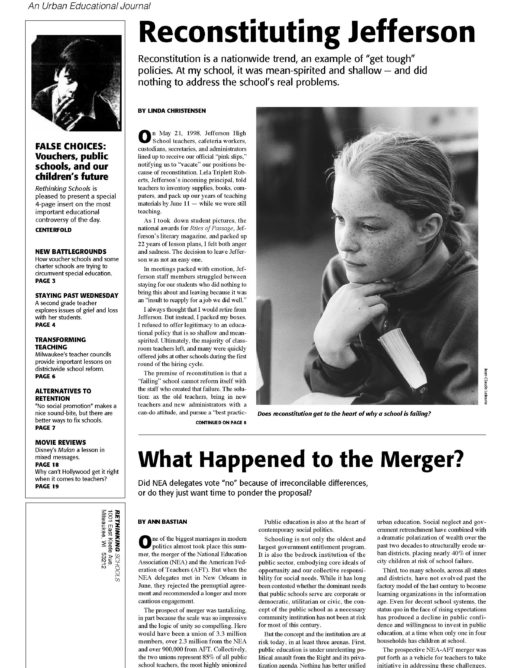Standardardized Tests
Standardized tests #1
In 1950, Martin Luther King, Jr. took the Graduate Record Exam, a standardized test from the Educational Testing Service that is used in applying to graduate school. King, often considered the greatest American orator of the century, scored “below average” on his verbal skills.
Standardized tests #2
Wisconsin Gov. Tommy Thompson, in his unsuccessful bid last spring for the state to take over the Milwaukee Public Schools, focused on Milwaukee’s problems with educating all students. Newly released data, however, show that Wisconsin’s other urban areas have difficulty educating poor and minority children – but have been more adept at covering up their failures.
In Green Bay, for example, the city’s aggregate test scores on the 10th grade reading test are questionable because 58% of Hispanic students in Green Bay did not take the test, as opposed to 15% in Milwaukee. In Madison, 19% of low-income students did not take the fourth grade math test, as compared to 9% in Milwaukee. Some 26% of African-American students in Beloit did not take the eighth grade math test, compared to 12% in Milwaukee.
Alex Molnar, the University of Wisconsin-Milwaukee professor who compiled the figures, concludes that many other districts artificially suppress data that makes the districts look bad, with the effect “of making the performance of other urban districts appear better than it actually is in relation to MPS because Milwaukee, for the most part, tests a higher percentage of its poor and its minority students than the other districts studied.”
The question of educating poor and minority children needs to go beyond pointing fingers at Milwaukee, Molnar said, and focus on how the state can help districts throughout Wisconsin “to ensure that poor and/or minority children succeed in Wisconsin’s public schools.”
Income Disparity
At a New Orleans hotel with 700 employees, the manager might earn $120,000 to $180,000 a year, according to a Aug. 18 article in The New York Times. The five assistant managers would make roughly $80,000 and the 50 or so supervisors $30,000 to $45,000. The vast majority of those 700 works – the housekeepers, waiters, and kitchen prep workers – earn less than $15,000 a year.
NIMBY!
Since 1992, New York City has shipped 400 tons of garbage every day to a 128,000-acre ranch outside the town of Sierra Blanca, TX.
Spending Gaps
If one factors in the costs of school renovation, disparities in per-pupil spending increase between Milwaukee and suburban districts. For example, Milwaukee spends about $8,346 per pupil, including school renovation monies. Fox Point-Bayside spends $16,438, according to a recent report by the non-partisan Public Policy Forum. Comparable figures for Nicolet are $13,101, and for Glendale-River Hills, $12,163.
MPS: Bigger Classes
Elementary school classes in Milwaukee have 23% more kids than the state average, according to a recent report by Wisconsin Citizen Action. In MPS, the average class in first through fifth grade has 27 students, compared to 22 throughout the state.
Making Money
The Education Industry Report covers for-profit, publicly traded education companies. In the last three years, it has grown from an 8-page to 12-page monthly newsletter. Its subscriptions price has grown, too. Effective July 1, 1998, a one-year subscription costs $379.
Guns Kill Kids …
Gunfire is expected to exceed automobile accidents as the leading cause of traumatic death in the United States in the next five years, according to Osha Gray Davidson, author of Under Fire: The NRA and the Battle for Gun Control. More teenagers die from gunshot wounds than from all natural causes combined.
… Meanwhile …
The National Rifle Association is pushing its “Eddie the Eagle Gun Safety Program.” Lessons are offered for children as young as pre-school.
Critics charge that the program is designed to present a benign image of the NRA, and to help children become comfortable with the idea of someday owning and/or handling a gun. Critics also point out that the problem is not just an issue of gun safety, but the easy availability of handguns.
According to the U.S. Justice Department, there are nearly 200 million privately owned guns in the United States – or almost one for every person. One household in three contains at least one firearm.

